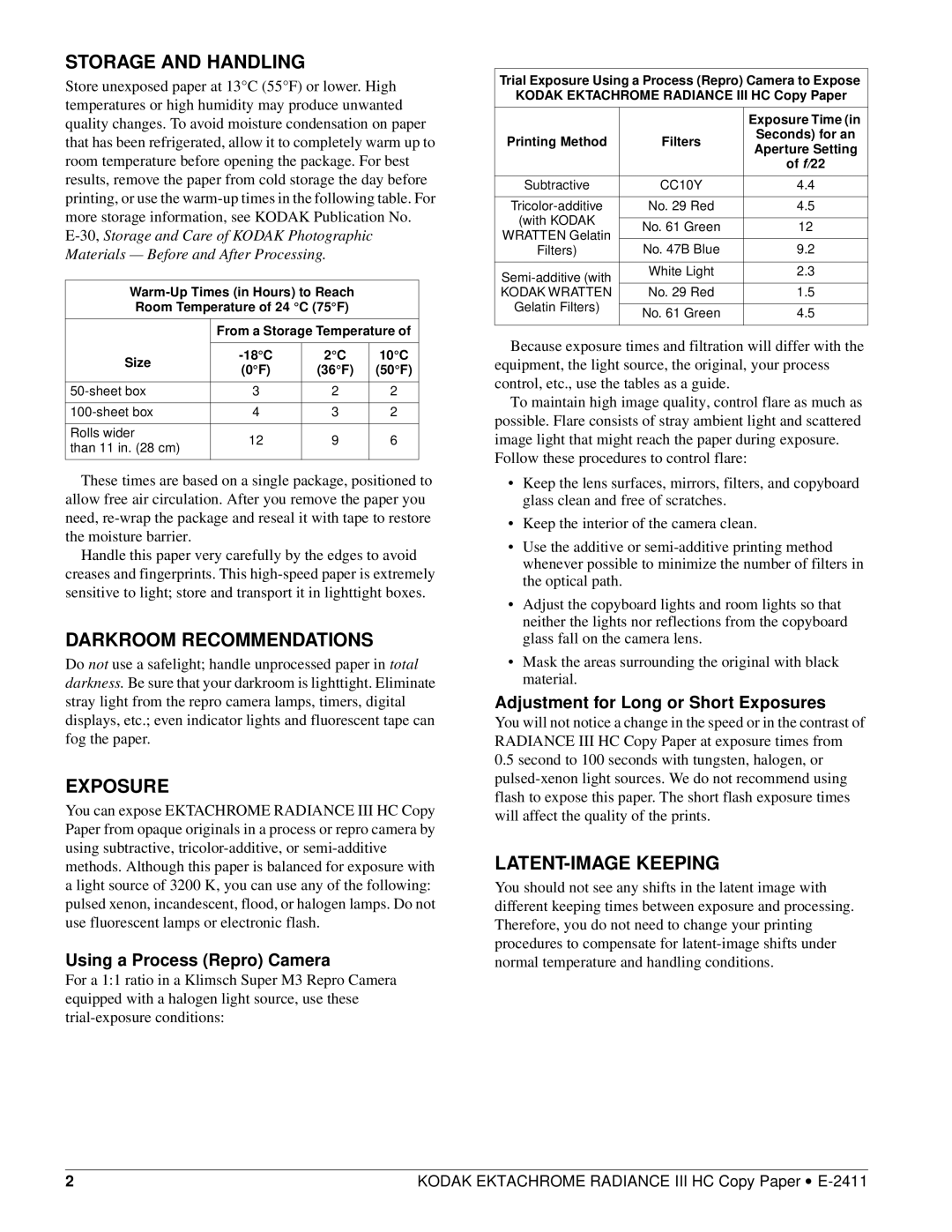
STORAGE AND HANDLING
Store unexposed paper at 13°C (55°F) or lower. High temperatures or high humidity may produce unwanted quality changes. To avoid moisture condensation on paper that has been refrigerated, allow it to completely warm up to room temperature before opening the package. For best results, remove the paper from cold storage the day before printing, or use the
Room Temperature of 24 °C (75°F)
| From a Storage Temperature of | |||
|
|
|
| |
Size | 2°C | 10°C | ||
(0°F) | (36°F) | (50°F) | ||
| ||||
|
|
|
| |
3 | 2 | 2 | ||
|
|
|
| |
4 | 3 | 2 | ||
|
|
|
| |
Rolls wider | 12 | 9 | 6 | |
than 11 in. (28 cm) | ||||
|
|
| ||
|
|
|
| |
These times are based on a single package, positioned to allow free air circulation. After you remove the paper you need,
Handle this paper very carefully by the edges to avoid creases and fingerprints. This
DARKROOM RECOMMENDATIONS
Do not use a safelight; handle unprocessed paper in total darkness. Be sure that your darkroom is lighttight. Eliminate stray light from the repro camera lamps, timers, digital displays, etc.; even indicator lights and fluorescent tape can fog the paper.
EXPOSURE
You can expose EKTACHROME RADIANCE III HC Copy Paper from opaque originals in a process or repro camera by using subtractive,
Using a Process (Repro) Camera
For a 1:1 ratio in a Klimsch Super M3 Repro Camera equipped with a halogen light source, use these
Trial Exposure Using a Process (Repro) Camera to Expose KODAK EKTACHROME RADIANCE III HC Copy Paper
|
| Exposure Time (in | |
Printing Method | Filters | Seconds) for an | |
Aperture Setting | |||
|
| ||
|
| of f/22 | |
|
|
| |
Subtractive | CC10Y | 4.4 | |
|
|
| |
No. 29 Red | 4.5 | ||
(with KODAK |
|
| |
No. 61 Green | 12 | ||
WRATTEN Gelatin | |||
|
| ||
No. 47B Blue | 9.2 | ||
Filters) | |||
|
|
| |
White Light | 2.3 | ||
|
| ||
KODAK WRATTEN | No. 29 Red | 1.5 | |
Gelatin Filters) |
|
| |
No. 61 Green | 4.5 | ||
| |||
|
|
|
Because exposure times and filtration will differ with the equipment, the light source, the original, your process control, etc., use the tables as a guide.
To maintain high image quality, control flare as much as possible. Flare consists of stray ambient light and scattered image light that might reach the paper during exposure.
Follow these procedures to control flare:
•Keep the lens surfaces, mirrors, filters, and copyboard glass clean and free of scratches.
•Keep the interior of the camera clean.
•Use the additive or
•Adjust the copyboard lights and room lights so that neither the lights nor reflections from the copyboard glass fall on the camera lens.
•Mask the areas surrounding the original with black material.
Adjustment for Long or Short Exposures
You will not notice a change in the speed or in the contrast of RADIANCE III HC Copy Paper at exposure times from
0.5second to 100 seconds with tungsten, halogen, or
LATENT-IMAGE KEEPING
You should not see any shifts in the latent image with different keeping times between exposure and processing. Therefore, you do not need to change your printing procedures to compensate for
2 | KODAK EKTACHROME RADIANCE III HC Copy Paper • |
